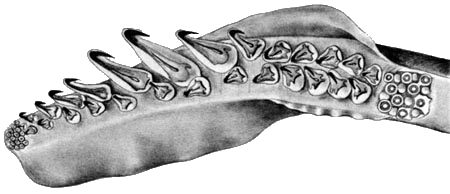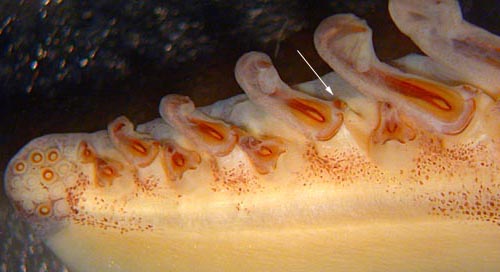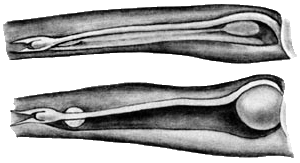Onychoteuthis borealijaponica
Michael Vecchione, Richard E. Young, Kotaro Tsuchiya, and K.S.R. BolstadIntroduction
Onychoteuthis borealijaponica is the most abundant onychoteuthid in the temperate to boreal North Pacific. It is the largest member of the genus, reaching a ML of 350 mm. The large number of hooks on the tentacular clubs, the most of any member of the genus, allows easy identification.


Figure. Oral view of O. borealijaponica, 50 mm ML. Drawing from Young (1971).
Diagnosis
An Onychoteuthis species...
- with 24-27 hooks on tentacular club.
- with two oval or teardrop-shaped intestinal photophores.
Characteristics
- Tentacular club
- Club with 24-27 hooks.
- Club without any marginal suckers in subadults.
- Several distal ventral-series hooks have spikes (arrow in bottom photograph points to most obvious spike).
 Click on an image to view larger version & data in a new window
Click on an image to view larger version & data in a new window

Figure. Oral views of the tentacular club of O. borealijaponica. Top - Full club, 81 mm ML, off southern California. Drawing from Young (1972). Bottom - Distal portion of preserved tentacular club, 175 mm ML, 45°N, 175°W. Photograph by R. Young.
- Head
- Beaks: Descriptions can be found here: Lower beak; upper beak.
- Beaks: Descriptions can be found here: Lower beak; upper beak.
- Photophores
- Visceral photophores slender: Posterior visceral photophore width ave. 61% of length (range 53-69%).
 Click on an image to view larger version & data in a new window
Click on an image to view larger version & data in a new window

Figure. Ventral views of visceral photophores: Top left - O. borealijaponica, 81 mm ML, off southern California. Drawing from Young (1972). Bottom left - Onychoteuthis sp., off Florida, with larger, round photophores. Drawing from Young (1972). Right - O. borealijaponica, 78 mm ML, preserved. Photograph by R. Young.
- Visceral photophores slender: Posterior visceral photophore width ave. 61% of length (range 53-69%).
Comments
Additional features of the description can be found here.Life History
O. borealijaponica migrates into subarctic waters to feed during the summer and returns to subtropical waters for spawning in fall and winter; males mature at about 250 mm ML and females at 300-350 mm ML (Kubodera et al. 1998).
Distribution
The type locality is the waters off Japan. This species occurs in the North Pacific from the Aleutian Islands to southern Japan and Baja California (Nesis 1982/87).
References
Kubodera, T., U. Piakowski, T. Okutani and M. R. Clarke. 1998 Taxonomy and zoogeography of the family Onychoteuthidae. Smiths. Contr. to Zoology, No. 585: 277-291.
Nesis, K. N. 1982/87. Abridged key to the cephalopod mollusks of the world's ocean. 385+ii pp. Light and Food Industry Publishing House, Moscow. (In Russian.). Translated into English by B. S. Levitov, ed. by L. A. Burgess (1987), Cephalopods of the world. T. F. H. Publications, Neptune City, NJ, 351pp.
Young, R. E. 1972. The systematics and areal distribution of pelagic cephalopods from the seas off Southern California. Smithson. Contr. Zool., 97: 1-159.
Title Illustrations

| Scientific Name | Onychoteuthis borealijaponica |
|---|---|
| Location | Eastern North Pacific off Monterey, California at 36.6°N, 122.1°W |
| Comments | In situ photograph of O. borealijapanica taken at a depth of 1348 m. |
| Acknowledgements | Images courtesy of the Monterey Bay Aquarium Research Institute (MBARI). You must obtain permission from MBARI to use this photo; please contact pressroom@mbari.org for further information. |
| Specimen Condition | Live Specimen |
| Identified By | R. E. Young |
| Behavior | Top right photograph - Squid has moved into a motionless Parachute posture. Bottom right - Note the overlapping tips of the locked tentacular clubs. |
| View | Dorsoanterior, anterior |
| Size | Unknown |
| Copyright | © 2013 MBARI |
About This Page

National Museum of Natural History, Washington, D. C. , USA

University of Hawaii, Honolulu, HI, USA

Tokyo University of Fisheries, Tokyo, Japan
K.S.R. Bolstad

Auckland University of Technology
Correspondence regarding this page should be directed to K.S.R. Bolstad at
Page copyright © 2019 , , , and K.S.R. Bolstad
 Page: Tree of Life
Onychoteuthis borealijaponica .
Authored by
Michael Vecchione, Richard E. Young, Kotaro Tsuchiya, and K.S.R. Bolstad.
The TEXT of this page is licensed under the
Creative Commons Attribution-NonCommercial License - Version 3.0. Note that images and other media
featured on this page are each governed by their own license, and they may or may not be available
for reuse. Click on an image or a media link to access the media data window, which provides the
relevant licensing information. For the general terms and conditions of ToL material reuse and
redistribution, please see the Tree of Life Copyright
Policies.
Page: Tree of Life
Onychoteuthis borealijaponica .
Authored by
Michael Vecchione, Richard E. Young, Kotaro Tsuchiya, and K.S.R. Bolstad.
The TEXT of this page is licensed under the
Creative Commons Attribution-NonCommercial License - Version 3.0. Note that images and other media
featured on this page are each governed by their own license, and they may or may not be available
for reuse. Click on an image or a media link to access the media data window, which provides the
relevant licensing information. For the general terms and conditions of ToL material reuse and
redistribution, please see the Tree of Life Copyright
Policies.
- First online 23 June 2003
- Content changed 08 January 2013
Citing this page:
Vecchione, Michael, Richard E. Young, Kotaro Tsuchiya, and K.S.R. Bolstad. 2013. Onychoteuthis borealijaponica . Version 08 January 2013 (under construction). http://tolweb.org/Onychoteuthis_borealijaponica/19963/2013.01.08 in The Tree of Life Web Project, http://tolweb.org/








 Go to quick links
Go to quick search
Go to navigation for this section of the ToL site
Go to detailed links for the ToL site
Go to quick links
Go to quick search
Go to navigation for this section of the ToL site
Go to detailed links for the ToL site